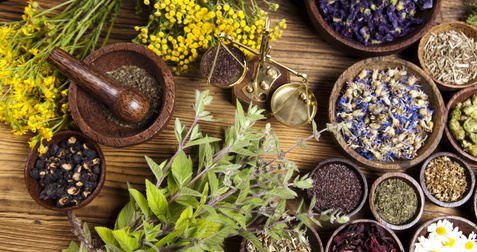Herbs A to Z
Here is a short list of common herbs and some their medicinal uses from a Western herbal medicine school of thought. Remember to always know where your herbs are sourced and how they are handled. Especially when it comes to supplements and essential oils! Also, be sure to learn about a herb or consult a professional before using it. Some herbs may have a different use when taken internally vs. an external application, so think about what it is you want to accomplish.
Aloe (Aloe vera) Liliaceae, Temp: Cold (Gelatinous substance in stalks)
Internally and externally helps injured tissue to heal. Great as an internal or external anti-inflammatory, especially when used with cold water. Aloe is a common plant and can be bought as a live plant, in stalks at the grocery store, or as juice. Fresh aloe from a living plant used as a facial moisturizer each day will keep the skin young.
Anise (Pimpinella anisum) Apiaceae, Temp: Warm (seeds)
A good mild expectorant. It aids in the treatment of coughs, colic, and bronchial inflammation, it is great for kids. Aids digestion of fatty foods and improves the body’s ability to assimilate nutrients. Can also be used to increase breast milk production.
Cayenne (Capsicum fructescence) Solanaceae, Temp: Hot (fruits)
Among improving circulation and helping the brain to secrete endorphins, cayenne has a wide range of uses. It can be used for asthma, arthritis, chills, colds, and coughs. Applied topically, cayenne can be used on wounds to help stop bleeding. You can also use cayenne between your socks and shoes to prevent foot odor.
Chamomile (Matricaria recutita) Asteraceae, Temp: Neutral (Flowers)
As many tea drinkers know, chamomile is used for calming and can help restore an exhausted nervous system. It is another herb that is great for children and can be used to stave off anxiety, insomnia, digestive distress, and irritability. It is also good at moving qi and clearing toxins.
Cinnamon (Cinnamomum cassia) Lauraceae, Temp: Hot (inner bark, twigs)
Cinnamon is one of the best herbs for stabilizing blood sugars. It works well for colds and can dry up dampness. It is excellent for circulation and can be used topically or in a soak to help increase blood flow to an area or injury. It also works for erectile dysfunction and as an aphrodisiac.
Cleavers (Gallium aparine) Rubiaceae, Temp: Cool (above round portion)
Lymphatic cleanser and good after a massage. Cleavers also helps the bod to get rid of uric acid and clear out waterways.
Red Clover (Trifolium pratense) Fabaceae, Temp: Cool (flowers, tops)
Great for detoxification and supporting all organs of elimination and great for health in general. Although it’s great, avoid red clover a week before surgery or while pregnant.
Dandelion (Taraxacum officinale) Asteraceae, Temp: Cold (all parts)
Dandelions are awesome! They aerate the soil, they contain a lot of lutein (the yellow nutrient molecule, every part is useful, and they have a myriad of benefits. Leaves can be collected in spring and used as a diuretic, and the roots can be used as a tea to detoxify the liver.
Echinacea (Echinacea purpurea, E. Angustifolia) Asteraceae, Temp: Cool (rhizome, leaves, flowers, seeds)
Echinacea is popular for its immune boosting properties; however, it is only useful when taken at the onset of cold or flu symptoms. It can help neutralize viruses and bacteria in the blood and stimulates the healing of wounds. Taking Echinacea all the time is not advised. People with compromised immune systems should only take Echinacea under the care of a qualified health care provider.
Garlic (Allium sativum) Liliaceae, Temp: Hot (bulb)
Garlic is a wildly useful antibacterial herb. It has a plethora of uses from helping the common cold to fighting tuberculosis. Garlic is considered one of the most important herbs in the world and is also totally delicious. When using garlic in cooking, to get the most health benefits one should wait 10 minutes after chopping or crushing garlic before adding it to heat. This allows the chemical compounds that give garlic its incredible benefits the time to mix and become heat resistant!
Ginger (Zingiber officinale) Zingiberaceae, Temp: Warm (rhizome)
Ginger is great for digestion and supports a lot of stomach functions. It can be used to combat motion sickness. Ginger warms the digestive organs and helps to improve digestive fire. Dried ginger is hotter than fresh, and is better for digestive problems. Fresh ginger can be used for respiratory problems.
Ginkgo (Ginkgo biloba) Coniferaceae, Temp: Neutral (leaves)
Ginkgo is a known herb to aid in brain function and activity. It also happens to be the oldest tree species on the planet due to its high resistance to disease and pollution. Gingko is great for issues with circulation and improves brain health by helping the blood supply more oxygen to everywhere in the body. It helps to heal and prevent blood clots. The leaves can be drunk as tea.
Asian Ginseng (Panax ginseng) Temp: Warm; American Ginseng (P. quinquefolius) Araliaceae, Temp: Cool (root)
Ginseng can support adrenals and is great as a supplement for aging. It is also great for stress as it is an adaptogen. Adaptogens help support the body during stress and normalize body processes. It can help balance hormonal and cholesterol levels, and aids the adrenals, particularly when they’re deficient. Another interesting fact is that ginseng can speed recovery times from sickness. Take it between meals/away from food.
Hawthorn (Crataegus oxycantha) Rosaceae, Temp: Warm (leaves, flowers, berries)
From a western view, hawthorn is a great heart tonic. From medicating the heart to helping to mend a broken one. In Chinese Medicine, it is used more for digestion. In Europe, it is prescribed in place of certain heart medications as it strengthens the heart muscles, improves circulation and regulates cholesterol.
Nettles (Urtica dioica) Urticaceae, Temp: Cool (all parts)
Nettle is one of my favorite plants! It is great for children, it supplies a ton of minerals to the body, it helps bones and hair growth, and is even great for the kidneys. Nettles pretty much do everything and nettle tea is wonderful for maintaining a healthy lifestyle.
Oatstraw, oat spikelets (Avena fatua, A. Sativa) Poaceae, Temp: cool (above ground portion, unripe seeds)
Oatstraw is great for dealing with issues in the nervous system, and the tea is good for dealing with stress and anxiety. It also helps to nourish the skin, teeth, nails, and hair. Oat can be used to help withdrawal symptoms and recovery after child birth. Oatmeal can also lower cholesterol and is tasty.
Peppermint (Mentha piperita) Lamiaceae, Temp: Cool (leaves)
Peppermint is a wonderful plant! It is a great digestive aid and pain reliever. Its cooling menthol can be applied topically as a poultice for a variety of reasons from arthritis pain to sore muscles. Peppermint is the strongest of all the mints medicinally and even helps to fight off bacteria. The Latin name for this plant is also hilarious as it means peppery mythical imp!
Raspberry leaf (Rubus idaeus) Rosaceae (leaves)
Energizing and antioxidant, raspberry leaves are very high in mineral content. It is really good for the uterus and is a great tonic for pregnant women. It is great for supporting sexual health and the nervous system. If you are trying to cut coffee out of your life, ty drinking raspberry leaf tea in the morning and you will have sustainable energy for your day!
Rosemary (Rosmarinus officinalis) Lamiaceae, Temp: Warm (leaves)
In Romeo and Juliet Rosemary was used for remembrance. It is a great herb for the elderly as it improves circulation, digestion, and brain function. It can be used to aid treatment of Alzheimer’s. Rosemary is great for a wide range of organ functions and when eaten as a seasoning can improve the digestion of starches and fats.
Saint John’s Wort (Hypericum perforatum) Hypericaceae (leaves, flowers)
Saint John’s Wort is a popular herb for stress relief and depression. It is an official herb in many Eastern European countries for the treatment of depression. The effects of this herb are not instantaneous. Try it regularly for 2 to 6 weeks to see the properties of the herb manifest. It should also NOT be taken in conjunction with other anti-depressant pharmaceuticals.

